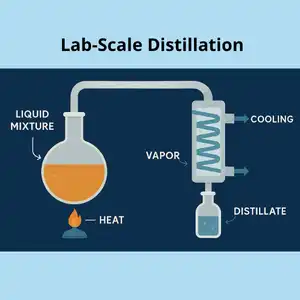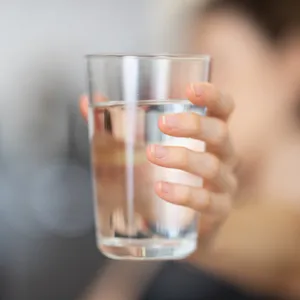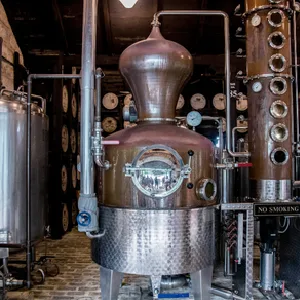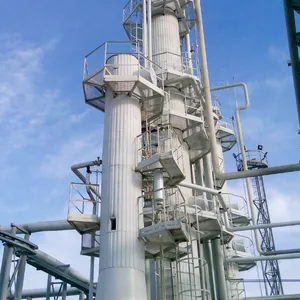
What is the process of distilling water?
Distilling water is the process of purifying it by heating it into vapor and then cooling that vapor back into liquid, leaving behind all impurities such as salts, minerals, and bacteria.
The diagram on the right shows a typical lab-scale distillation setup.
Step-by-step, here’s how it works:
- Heat is applied to a container holding the impure water (called the “liquid mixture” in the diagram).
- As the water reaches its boiling point, it turns into vapor — while contaminants stay behind, since they do not evaporate.
- The vapor travels through a tube to the cooling coil (condenser), where it’s chilled and returns to the liquid state.
- The purified water — now called distillate — drips into a clean collection container.
This process is called simple distillation, and it’s commonly used to obtain clean water in labs, households, and survival setups.
The process is based on the physical phenomena of liquid–vapor equilibrium that occur when a substance is heated.
The liquid evaporates (turns into vapor) and then condenses again (returns to liquid) to separate components based on their volatility.
What are the benefits of distilling water?
By using distillation, it is possible to remove or reduce:
- Limescale and mineral deposits (e.g., calcium, magnesium)
- Heavy metals such as lead, mercury, and arsenic
- Bacteria, viruses, and parasites
- Chemicals like nitrates, sulfates, and certain pesticides
- Microplastics and sediment particles
- Chlorine and other treatment by-products
- Electrical conductivity (important for sensitive devices)

How to Obtain Distilled Water
Distilled water can be obtained using industrial distillation systems—often found in laboratories, pharmaceutical plants, and water treatment facilities—or through smaller countertop distillers designed for household use.
In all cases, the principle remains the same: only the vapor is collected, while non-volatile substances are left behind. The result is water with low conductivity and high purity, suitable for technical, medical, or domestic applications.
The effectiveness of distillation in removing specific contaminants may vary depending on the equipment used and the operating conditions.
In industrial settings, distillation is tightly controlled and can remove a wide range of contaminants, including:
- Dissolved salts and minerals
- Heavy metals (e.g., lead, arsenic, mercury)
- Microorganisms (bacteria, viruses)
- Organic compounds and volatile chemicals
- Microplastics and fine particulates
- Residual solvents and treatment by-products
In home environments, simpler distillation systems can still be reasonably effective, particularly for reducing:
- Limescale and mineral deposits (e.g., calcium, magnesium)
- Most heavy metals
- Chlorine and some organic compounds
- Sediment and certain types of microplastics
- A significant portion of bacteria and other pathogens
However, home distillation may not remove all volatile chemicals or ensure complete sterilization, especially without additional features like post-filtration or multiple distillation cycles. For high-purity applications—such as medical, laboratory, or electronic use—industrial or laboratory-grade distilled water is recommended.
At home, water is usually distilled by heating it in a pot until it turns to steam, then collecting that steam using a lid or cooling surface so it condenses into a separate, clean container. This basic setup mimics the industrial process on a small scale, using household materials like a metal pot, a glass bowl, and ice to cool the lid. Some people also use countertop electric distillers, which automate the entire process and improve consistency.
Electric Water Distillers (Efficient & Automatic)
If you need distilled water regularly, an electric distiller like the CO-Z 4L Stainless Steel Distiller is a smart solution for home use. These compact devices:
- Boil water automatically
- Use a cooling fan to condense steam efficiently
- Collect the distilled water in a dedicated glass or plastic jug
They typically produce around 4 liters every 4–6 hours, making them perfect for daily household needs—whether for drinking, appliances, or lab use.
💡 Tip: You can find this model and similar ones on Amazon.
If you go through a lot of distilled water, this one-time investment pays off quickly compared to constantly buying bottled water.
👉 Check availability and price on Amazon (affiliate link)
Distilled vs Purified Water: What’s the Difference?
Many people confuse distilled water with purified water — but they’re not exactly the same.
Distilled water is made by boiling water, collecting the vapor, and condensing it. This process removes:
- Minerals
- Bacteria and viruses
- Most chemical contaminants
Purified water refers to water that has been treated using other methods, such as:
- Reverse osmosis
- Deionization
- Carbon filtration
Both are very clean, but distillation tends to remove more types of impurities, especially inorganic ones. However, it also removes beneficial minerals like calcium and magnesium.

What Is the Process of Distilling Alcohol?
Distillation of alcohol is one of the oldest and most common applications of distillation. The process follows the same basic principles: heat a liquid mixture, collect the vapor, and condense it to separate components based on their boiling points.
Alcohol has a lower boiling point than water (about 78.5 °C), so when a mixture like a fermented liquid is heated, alcohol evaporates first. This vapor is then cooled and collected as a more concentrated alcoholic solution.
Typical Steps in Alcohol Distillation:
- Fermentation – Sugars are converted to alcohol by yeast.
- Heating – The fermented mixture is heated in a distillation apparatus.
- Evaporation – Alcohol vapor rises through a distillation column or fractionating column.
- Condensation – The vapor is cooled and turned back into liquid alcohol.
- Collection – The purified alcohol is collected in a separate container.
This process is used both in industrial alcohol pro
Safety Issues in the Process of Distilling Alcohol
The process of distilling alcohol is more complex — and riskier — than distilling water. It involves flammable substances, precise temperature control, and potential legal restrictions.
Here are the key safety concerns to consider:
- Fire hazard: Ethanol vapors are highly flammable. A small spark near the still can cause a fire or explosion.
- Explosion risk: A sealed or improperly vented still can build dangerous pressure. Always allow vapor to escape safely.
- Toxic alcohols: If not properly monitored, the distillation process can produce methanol, which is toxic even in small doses.
- Inhalation hazard: Fumes from the distillation process, especially indoors, can affect your health. Use good ventilation.
- Material contamination: Low-quality or homemade equipment can leach heavy metals or unsafe chemicals into the product.
- Legal issues: In many countries, distilling alcohol at home is illegal without a license, regardless of the purpose.
How Are the Most Popular Alcoholic Drinks Distilled?
Whiskey
- Fermented from barley, rye, corn, or wheat mash
- Distilled in pot stills or column stills
- Heads and tails are discarded
- The “heart” cut is collected
- Aged in oak barrels to develop flavor

Vodka
- Fermented from potatoes, grains, or sugar beets
- Distilled in high-efficiency column stills
- Often distilled multiple times for maximum purity
- Tails are removed to ensure a clean, neutral taste
- Commonly filtered through charcoal
Rum
- Fermented from sugarcane juice or molasses
- Distilled in pot stills (for full-bodied rum) or column stills (for lighter rum)
- May be aged in barrels, depending on the style
- Often blended to achieve the final flavor
Gin
- Based on neutral alcohol, usually from grains
- Distilled with botanicals such as juniper, coriander, or citrus peels
- Flavor is infused through vapor distillation or maceration during the process

What Is the Process of Distilling Oils?
Distilling essential oils is a very different process compared to distilling water or alcohol. While water distillation is mainly about removing impurities, and alcohol distillation focuses on separating ethanol for consumption, oil distillation is all about capturing delicate aromatic compounds from plants — without destroying them.
Unlike water and alcohol, which are simple fluids with a single boiling point, plant materials contain complex mixtures of volatile and non-volatile components. This makes the distillation of oils both more sensitive and more specialized.
Essential Oils: Volatility and Temperature
Essential oils are made of volatile aromatic compounds that can degrade or transform if exposed to excessive heat. While water boils at 100 °C (212 °F) at standard atmospheric pressure, many essential oil components begin to evaporate at much lower temperatures — often between 50 °C and 80 °C — yet they remain trapped within plant structures that require heat to release them.
Boiling plant material directly can damage the oils’ chemical integrity. That’s why steam distillation is used: it allows the extraction of these compounds at lower effective temperatures. In a steam distillation setup, the combination of steam and reduced pressure lowers the boiling point of the oil–water mixture, enabling gentle evaporation without burning or degradation.
According to a 2022 peer-reviewed study published in the journal Sustainability, steam distillation remains the most widely used method for essential oil extraction, primarily due to its simplicity and low investment requirements (Machado et al., 2022).
Home Distillation Made Easy: Two Smart Options for Essential Oils
If you’re exploring essential oil distillation at home, here are two great options by LETIME — one automatic and one traditional.
🔹 Option 1: LETIME ADI Automatic Herbal Extractor
A compact, all-in-one device that distills essential oils, hydrosols, and purified water (up to 4 L).
- Dual function: infuser + distiller
- Fully automated with built-in fan and condenser
- Stainless steel design, easy to use and clean
Perfect for beginners who want fast, safe results with lavender, mint, or citrus.
View on Amazon – LETIME ADI Herbal Oil & Water Distiller (Affiliate link)
🔹 Option 2: LETIME 3L Traditional Steam Distillation Kit
For hands-on users who prefer full control, this classic stainless steel setup distills herbs, flowers, and roots.
- Includes pot, column, condenser, and tubing
- Manual or electric cooling
- 3L capacity (2L water + 1L herbs)
Ideal for natural hydrosols and DIY aromatherapy.
View on Amazon – LETIME 3L Steam Distillation Kit (Affiliate link)
Ing. Ivet Miranda
⬆️ Back to TopLooking to Build a Stronger Foundation in Chemical Engineering? Start Here:
- What does it mean to be an Engineer?
- What Does a Chemical Engineer do in Industrial Environments?
- Chemical Engineer Salary
- Unit Operations: A Practical Introduction for Engineers
- What is Distillation?
- What is the process of distilling water, alcohol, and oils?
- The 4 Management System Pillars in a Chemical Plant
- FREE PDF 4 PILLARS OF SMS
- Engineering Approach to Thermodynamics
- Safety Relief Valve vs Rupture Disc: 5 Key Engi Insights
- Engineering Problem-Solving in 7 Steps
- Rupture Disc: Contained Release or LOC
FAQ
Can I use a water distiller to make essential oils?
Not exactly. Standard water distillers are designed to purify water only. To extract essential oils, you need a system specifically built for steam distillation of plant material — like the LETIME ADI or LETIME 3L kits.
What’s the difference between a steam distillation kit and an electric oil extractor?
Steam distillation kits are manual and give you more control over the process, while electric extractors automate heating and cooling, making them easier and safer for beginners.
Can I use these devices to purify drinking water too?
Yes — the LETIME ADI model is dual-purpose and can produce up to 4L of distilled water per cycle, making it useful for irons, humidifiers, or emergency water needs.
What Exactly Is a “Spirit” in Distillation?
In the world of distillation, a “spirit” refers to a distilled alcoholic beverage that contains a high concentration of ethanol. Common examples include whiskey, vodka, gin, rum, tequila, and brandy.